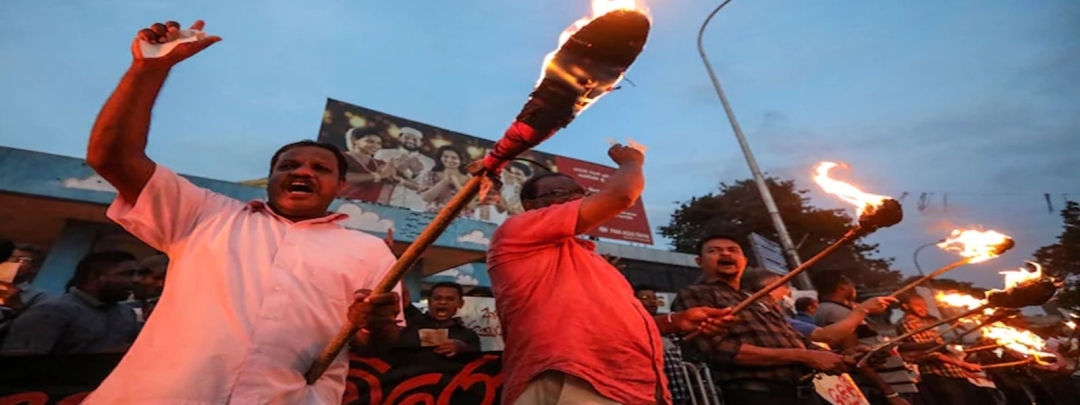Far from Ukraine, Sri Lanka is the epicenter of a global crisis

The war in Ukraine may still dominate international headlines. But it’s a country far from the battlefield that has turned into a kind of crucible of the global moment. For months, Sri Lanka has been in an economic death spiral: A public debt crisis, exacerbated first by the toll of the pandemic and then the disruptions provoked by Russia’s invasion of Ukraine, has led to shortages in food, fuel, cooking gas, medicines, cash and other essential commodities.
In a United Nations survey, some 70 percent of Sri Lankan households reported cutting back on food consumption, with food price inflation running at around 57 percent (contrast that to roughly 10 percent in the United States from the previous year). The country of 22 million people is more or less out of fuel and fresh shipments are still days away.
Mounting public anger and protests brought down the government of Prime Minister Mahinda Rajapaksa in May, but crisis conditions endure and fears grow over the potential of new clashes between security forces and ordinary, irate civilians. Rolling power cuts are now standard parts of daily life, as are days-long lines for fuel. Schools and offices have been closed at least through the week in a bid to keep Sri Lankans off the roads.
Last week, doctors, medical staff, teachers and bankers in the capital Colombo marched in protest of their inability to get the necessary petrol or diesel to carry out essential work. “Things have become unbearable for the common man,” said a teachers union official to Reuters.
Sri Lanka in May defaulted on its debt for the first time in its history as an independent nation. A caretaker government led by savvy veteran politician Prime Minister Ranil Wickremesinghe is attempting to steer the country out of its troubles, including by soliciting aid from regional powers India and China.
But the road ahead remains bleak for a country unable to pay for its imports. The government has resorted to rather desperate appeals: It introduced a scheme to give government employees an extra day off to grow crops in their backyards and also offered all of the nation’s 1.5 million public sector workers the possibility of taking five years unpaid leave so they could find employment abroad, emigrate and send much-needed remittances home.
Lines at passport offices are now lengthy, too, and the country’s online application system has been backlogged for months. The most desperate are attempting to flee via boat to nearby countries such as India. Analysts have likened the wipeout of the Sri Lankan economy to the financial chaos of the late 1990s in Southeast Asia’s major economies. Others warn of Sri Lanka turning into “South Asia’s Lebanon,” debt-ridden and dysfunctional.
Ten days of negotiations that began June 20 between the country’s interim government and officials from the International Monetary Fund over a potential bailout package concluded last week with no resolution. “In the past, we have held discussions as a developing country,” Wickremesinghe said Tuesday. “But now the situation is different. We are now participating in the negotiations as a bankrupt country. Therefore, we have to face a more difficult and complicated situation.”
Sri Lanka’s problems are, in many aspects, unique to its situation and self-inflicted. Yet the astonishing collapse of the country is also inextricably linked to a wider, interlocking series of global phenomena: The war in Ukraine has spiked global food and energy prices and pushed a tough situation in Sri Lanka over the edge.
“Sri Lanka would be in crisis even if you didn’t have a war in Ukraine, but it’s compounding everything,” Alan Keenan, an analyst at the International Crisis Group consultancy, said to my colleague Gerry Shih earlier this year. “This is the Ukraine effect: a credit line for fuel you thought could last two months now lasts one. Even if you get a bailout, you’re buying less food, less fuel, less medicine.”
Similar pressures exist elsewhere. A joint report from international humanitarian groups Oxfam and Save the Children in May found that one person is dying of hunger every 48 seconds in drought-ravaged Kenya, Ethiopia and Somalia. The conflict in Ukraine had led to prices spiking to record levels and made food “unattainable for millions” of people in East Africa.
“The number of people experiencing extreme hunger in the three countries has more than doubled since last year — from over 10 million to more than 23 million today,” the organizations noted in a statement. “This is against a backdrop of crippling debt that more than tripled in under a decade — from $20.7 billion in 2012 to $65.3 billion by 2020 — sucking these countries’ resources from public services and social protection.”
